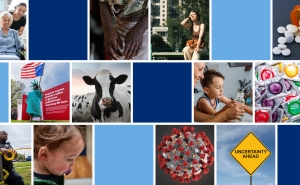Food Insecurity in the Time of COVID

Even before the COVID-19 pandemic disrupted food supplies, health systems, and global nutrition programs, 800 million around the world were undernourished (supplied with less than the minimum amount of the nutrients or foods essential for sound health and growth). Children were especially vulnerable: 144 million children under five were stunted (low height-for-age). 47 million children were affected by wasting, a life-threatening form of malnutrition.
As nutrition policy expert Rebecca Heidkamp and co-authors wrote in a Nature study, “the world was already not on track to achieve Sustainable Development Goal 2—to eliminate hunger and all forms of malnutrition by 2030.”
The goal of their study was to model the potential short- and long-term impacts the pandemic would have on nutrition and recommend policies to mitigate damage.
With modeling tools, they were able to determine potential impacts under optimistic, moderate, and pessimistic scenarios from 2020 to 2022. One big challenge was that the pandemic itself interfered with capturing critical data—in this case, an exact count of wasted and stunted children.
“We’ve been struggling to know what the actual impacts have been,” says Heidkamp, PhD, an associate scientist in International Health who specializes in developing nutrition policy in low- and middle-income countries. At the start of the pandemic, UN agencies, including WHO and UNICEF, were dependent on phone surveys to collect data. This meant researchers “couldn’t go out and actually measure women and children,” she says, and “that’s what we care about in nutrition.”
The study points to evidence from phone surveys in Asia and Africa revealing disruptions in food supply chains and a spike in food prices resulted in dramatic increases in poverty and food insecurity in 2020, forcing families to shift to poorer diets.
Since the start of the pandemic, countries like India and Brazil have adapted and scaled up government assistance programs and social safety net programs, such as social protection and cash and food transfers, but public health experts predict these efforts will be insufficient to return to living standards seen prior to the pandemic.
Standing Together for Nutrition: A Trusted, Unified Voice
Early in the pandemic, lockdowns especially posed a threat to global nutrition efforts, including the disbursement of iron supplements through prenatal care for pregnant people at high risk of anemia; food assistance for families, such as staples like flour, cereal, beans, and lentils; and routine interventions to prevent and treat acute malnutrition. In addition, school closures halted school feeding programs.
The crisis led to the creation of a research and advocacy consortium involving several Bloomberg School faculty including Heidkamp, called Standing Together for Nutrition, or ST4N.
The group includes nutrition, economics, and food and health systems experts. Their goal: to identify the potential impacts of COVID—and now the war in Ukraine—on food security and nutrition in low- and middle-income countries, and ultimately recommend nutrition interventions to mitigate excess stunting and child mortality.
“Now rising costs of products used to treat malnutrition are threatening to interrupt those programs as they cannot reach as many, even as the need goes up,” says Heidkamp.
The study reports that in 2019, the UN World Food Programme estimated that 150 million people in 81 different countries needed food assistance. In February of 2022, it rose to 276 million people. The agency predicts that number to increase to 323 million this year alone.
Heidkamp anticipates that 2022 will be a big advocacy year for nutrition. “There are many challenges as we look ahead. … but we need to keep shining the light on these issues and figure out who the right global players will be,” she says.
In the Nature piece, Heidkamp and co-authors urge “governments, donors, and the UN to help prevent a major exacerbation of malnutrition.” They recommend succinct steps these players must take to build more sustainable food systems that can help support affordable and nutritious diets for all:
- End trade restrictions that affect access to nutrition.
- Sustain or implement social protection programs.
- Protect national nutrition budgets.
- Honor commitments already made.
- Mobilize more resources for humanitarian assistance.
Heidkamp says it’s donors and affluent groups like the World Bank that have the power to strongly influence other countries toward ending trade restrictions, implementing social protection programs, and activating humanitarian assistance in order to end food insecurity and malnutrition.
Grace Fernandez is a communications and marketing specialist in the Office of External Affairs at the Johns Hopkins Bloomberg School of Public Health.





